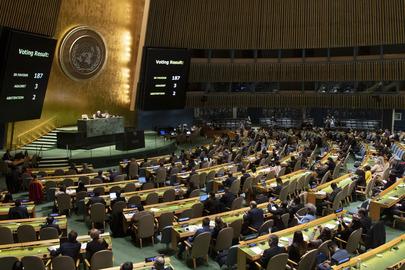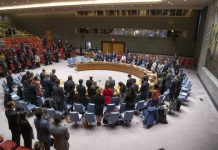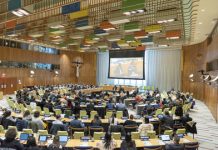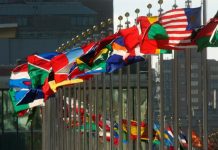Sikaiana, less than two square kilometres, is encircled by the sea and is home to just 300 people. It is also more than 200 kilometres from the main island of the Solomon archipelago.
Most homes lie steps from the shore, where high tides flood the tree line and seep into wells, making freshwater scarce.
Still, life continues with a sense of routine. Children walk barefoot to school, fishermen prepare their nets, and families tend to their gardens as they always have.
At the island’s only school, Principal Tuiao Kapule pauses to draw rainwater from a storage tank – a precious resource on this isolated atoll where every drop counts.
“When I was growing up, life in Sikaiana wasn’t like this,” he says. “Now the tides are higher, saltwater levels have risen, and it’s harder to grow food the way we used to.”
He watches his students playing nearby, their laughter echoing through the schoolyard. “Families are finding it hard to cope with the changes,” he says. “Some students stay home when there isn’t enough to eat.”
As rising tides reshape life on Sikaiana, Principal Tuiao Kapule worries about what the future holds for the tiny atoll.
Later that afternoon, Tuiao stands outside his home with his youngest in his arms.
“Sikaiana is my motherland,” he says quietly. “But if we ever have to leave, I will go. Life on this island is no longer what it used to be.”
His story mirrors that of Mary Maike, a community elder who has lived her whole life by the sea.
“When there’s heavy rain, we can’t harvest,” she says. “Our gardens depend on the weather. When the sun stays out too long, the tanks run dry, so we have to find wells, collect water, and boil it before we can drink.”
Mary Maike a resident of Sikaiana.
She watches her grandchildren play as elders rest nearby; island life continues as always.
“If we have to relocate, it will be up to our leaders,” she explains. “Even if we agree to move, we don’t know where we would go. We’d rather stay near the sea because we rely on fishing and collecting shells. Moving inland would make life very hard for us.”
Across the Solomon Islands, stories like Tuiao’s and Mary’s are growing more common as rising seas, stronger storms, and changing weather reshape daily life—flooding gardens, contaminating wells, and eroding coastlines.
On Sikaiana, change is clear – the atoll rises just four metres above sea level, shielded only by a narrow band of mangroves.
For Tuiao, Mary, and other low-lying Pacific communities, there is no higher ground. Seawalls are too costly and difficult, leaving relocation as the only viable option.
Sunset over Sikaiana, a remote atoll located more than 200 kilometres from the nearest main island.
The fate of small islands threatened by climate change is one of the issues that will be discussed by delegates to the UN Climate Conference (COP30) taking place in Belém, Brazil.
It’s not a new challenge.
In 2022, the Solomon Islands Government, with support from the International Organization for Migration (IOM), launched the Planned Relocation Guidelines – a framework for managing the relocation of communities from high-risk areas as a last resort.
IOM is assisting the Government in developing a standard approach for the planned move, making sure it is transparent, inclusive, and upholds the dignity of islanders while ensuring their long-term future.
As the sun sets in Sikaiana, waves break softly against the shore, a steady rhythm that has long defined life on the island. Yet beneath the calm surface lies uncertainty – how long can this way of life last?
Like many families across Solomon Islands, Tuiao and Mary hope want their children to have a safe home and a future they can build with pride. Whether they remain on Sikaiana or move elsewhere, their unity and strength sustain them with dignity.
Source of original article: United Nations (news.un.org). Photo credit: UN. The content of this article does not necessarily reflect the views or opinion of Global Diaspora News (www.globaldiasporanews.com).
To submit your press release: (https://www.globaldiasporanews.com/pr).
To advertise on Global Diaspora News: (www.globaldiasporanews.com/ads).
Sign up to Global Diaspora News newsletter (https://www.globaldiasporanews.com/newsletter/) to start receiving updates and opportunities directly in your email inbox for free.













